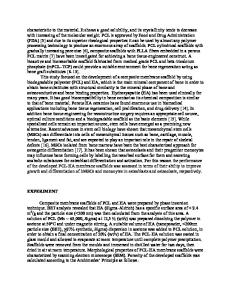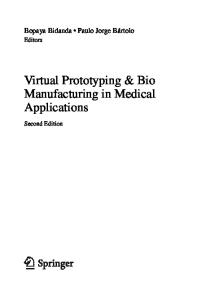Functionalization of Nanofibrous Spiral Structured Scaffolds for Bone Tissue Engineering
- PDF / 203,695 Bytes
- 6 Pages / 612 x 792 pts (letter) Page_size
- 57 Downloads / 373 Views
1235-RR03-41
Functionalization of nanofibrous spiral structured scaffolds for bone tissue engineering Junping Wang, Xiaojun Yu Department of Chemistry, Chemical Biology, and Biomedical Engineering, Stevens Institute of Technology, Hoboken, NJ, 07030
ABSTRACT In the previous studies, we have successfully developed a novel spiral structured nanofibrous scaffolds with improved osteoconductivity for bone tissue engineering1. The spiral structure design facilitates the nutrient transport and waste removal, and allows uniform cellular growth and distribution within the scaffolds, thus enhanced the bioactivity of the scaffolds. In this chapter, HAP and BMP-2 were incorporated within the nanofibrous spiral scaffolds in order to enhance the osteoinductivity of the established system. The effect of the blending materials was evaluated through cell proliferation, cell differentiation of human osteoblast cells seeded on the scaffolds and cultured for 4 and 8 days. The results has demonstrated that the functionalization of PCL nanofibrous spiral scaffolds leads to higher ALP expression level and increased amount of mineralization level however lower cell proliferation rate.
INTRODUCTION Hydroxyapatite has been applied to bone application for a long time due to the fact that it is the major inorganic components of natural bone. In natural bone matrix, hydroxyapatite crystals bound to collagen nanofibrils through proteins such as osteocalcin, osteopontin or osteonectin2. In bone tissue engineering application, the major function of HAP is to be used as an oteoinductive ingredient to promote the alkaline phosphatase expression and mineralization3-7. Secondly, as a type of bioceramic, HAP has been used as a reinforcing material in combination with other polymers to form polymer/HAP composites3; however, it was rarely used alone in preparing scaffolds due to its brittle property. A nano hydroxyapatite/ poly(ester urethane) scaffold has been reported to have 50% increase of Young’s modulus by addition of 10%HA4. Finally, the incorporation of HAP to some polymers has also been shown to affect the crystallinity and the degradation of the blending polymers. A recent study has demonstrated that the presence of HAP within polycaprolactone (PCL)/HAP composites not only enhanced the bioactivity of the scaffolds but also influenced the degradation of the composites by faster mechanisms than pure PCL scaffolds5. The performance of HAP within the scaffolds is not only determined by the HAP itself but also is determined by the polymer used within the composites. Moreover, for the same type of blending polymer, the bioactivity of HAP is also dependent on the polymer: HAP ratio and fabrication method. Among all the biodegradable polymers for bone tissue engineering, PCL was the most widely used blending material with HAP due to its weak mechanical strength. The most straightforward way is to directly disperse the HAP particles in PCL polymer solution or melted PCL solution6. A large portion of HAP could be incorporated through this method. Scaf
Data Loading...











